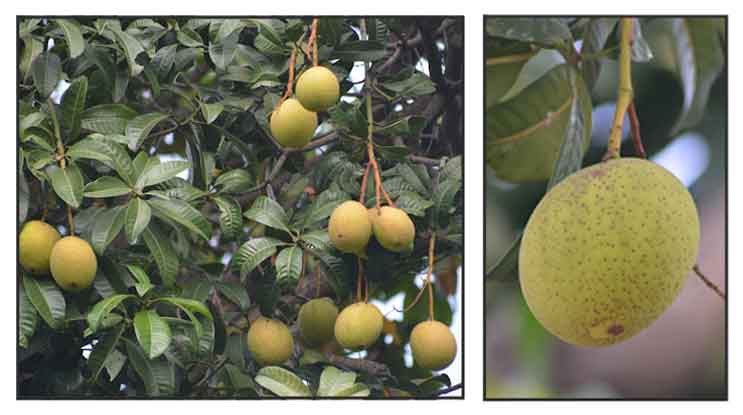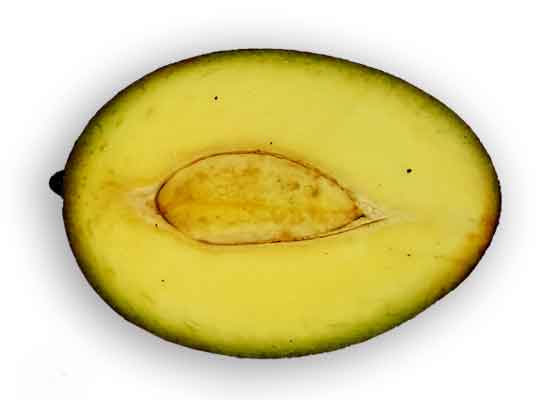
Gen info
When in flower, considered the most beautiful of mango trees with its copper-red inflorescences and pink flowers.
 Botany Botany
Mangifera foetida is a tree growing up to 40 m tall. Bole straight without buttresses. Bark is light brown to greyish-brown, shallowly fissured with broad flat ridges, containing irritant whitish sap that turns black on exposure. Crown is dense. Branches are massive. Leaves are spirally arranged; stalked leaves possess rigid and thick leathery leaf blades that are narrowly drop-shaped, oval or oblong, 12-38 by 6-16 cm, dark green above, clear green below, apex subacute, sometimes rounded or slightly emarginate, base cuneate or attenuate; petioles 1.5-8 cm, stout, very swollen at the base. Panicles are subterminal, upright, pyrramidal, 10-4- cm long, sparsely branched, densely flowered. Flowers are in flowering shoots, copper red, and 10-41 cm long, pinkish or deep red. Fruit is variable in shape, obliquely egg-shaped or almost globose drupe, fleshy, yellowish or greyish green, 7.6-18 by 6-12 cm. Ripe fruit is strongly scented with a taste of turpentine at its full extent. Single seed is enclosed in a woody capsule in the center of the fruit flesh, 6 by 5 by 3 cm, coarsely fibrous. (2)
Distribution
- Exotic to the Philippines.
- Native to Borneo, Cambodia, Malaya, Myanmar, Sumatera, Thailand, Vietnam.
- Usually in primary lowland forest in the wet tropics. Adapts to areas with abundant rainfall, grown up to elevations above 1000m.
Constituents
- The edible portion represents 65% of the fruit weight. Per 100 g edible portion the flesh contains water 72.5 g, protein 1.4 g, carbohydrates 25.4 gm, calcium 21 mg, phosphorus 15 mg, thaimine 0.03 mg, beta carotene equivalent 0.218 mg and vitamin C 56 mg. (4)
- In a study of 3 medicinal plants for TPC, the highest amount of phenolic compounds was found in the bark of M. foetida (24.642 ± 11.087 mg GAE/g). Abundance of TPC in descending order was: bark > pericarp > leaves. Total flavonoid contents in bark, pericarp and leaves were 19..557, 12.057, and 17.295 mg QE/g, respectively. (5)
- Phytochemical screening of leaf ethanol extract yielded phenols, flavonoid, tannins, saponins, alkaloids, and steroids. (see study below)
(10)
- Study of twigs yielded three new compounds, two triterpenes, mangiferenes A (1) and B (2), and one coumaryl glucoside, mangiferene glucoside (3), along with 19 known compounds. The compounds were evaluated for antioxidant and antibacterial activities.
(13)
- Study of methanol extract of M. foetida leaves for mangiferin levels
by Thin-Layer Chromatography (TLC) Densitometry method yielded percentage levels around 0.28 ± 0.004%. (14)
- In a GC and GC-Ms study of fruits for volatile components, 84 components were identified in the bachang fruit, and esters 55.7% and oxygenated monoterpenes (20.3 were dominant, and ethyl butanoate (33.4%) as most abundant. (15)
Properties
Studies have suggest antibacterial, antioxidant, immunomodulatory, iron chelating, mosquito larvicidal, pancreatic lipase inhibitory properties.
Parts used
Leaves, bark, seeds, fruit.
Uses
Edibility
- Fruit is edible, mildly sweet and delicately flavored.
-
Young fruits can extrude sap that can cause blisters. At maturity, the irritant juice is restricted to the skin, and the ripe fruit can be eaten fresh if peeled fairly thick. (4)
- Unripe fruit washed in salted water is sliced and added to vegetable salads ('rujak') and in a sour pickle ('asinan').
(4)
- Fruits used in curries, pickles, rojak, and to make chutneys or sweetmeats.
- Grated seed in a mixture of oncom (Monilia fermented soybean), sugar, tersai (fermented fish) and salt creates a sambal known as "pelok limus". (2)
Folkloric
- In Vietnamese folk medicine, dry leaves used in tea to assist with sleeping.
- Bark made into lotion used for treating ulcers. Leaves use to alleviate fever. Seeds used for eczema, scabies, and trichophytosis.
(2)
Others
- Wood. Wood is not durable but suitable for light indoor construction, turnery, flooring, paneling, boxes, crates, etc. Corewood can be used for decorative veneer production. Streaked heartwood suitable for furniture making. (3)
- Sap: The resinous sap in the stem is used to deepen tattoo scars.
(2)
- Ornamental: Flowers makes for a beautiful ornamental.
Studies
• Antibacterial / Dental Caries / Leaves: Study evaluated the antibacterial potential of M. foetida leaf extract against Streptococcus mutans, the dental caries causing bacteria. Results showed bachang leaf extracts significantly inhibited the growth of S. mutans with inhibition zones ranging from 13.74 mm to 19.22 mm, at similar effect at maximum concentration as erythromycin. At MIC of 14%, the extract exhibited bactericidal properties by MBC test. (6)
• Antioxidant / Fruits: Study evaluated the antioxidant capacity and components (reducing, flavonoid, carotenoid, and ascorbic acid contents) of fresh powder and fiber products prepared from M. foetida fruit. The antioxidant capacity of fresh, powder, and fiber products were in the order of fresh > fiber > powder. Based on ß-carotene bleaching method, antioxidant capacity was fiber > powder > fresh. There was a positive and significant correlation (r>0.9) between antioxidant capacity and certain antioxidant components. (7)
• Prevention of Iron Overload / Leaves: M. foetida leaf extract reduced the levels of iron in IO in vitro and in vivo models. Study evaluated the efficacy of M. foetida leaf extract in the prevention of iron overload in Sprague-Dawley rats. Experimental iron overload increased plasma Fe content 4.23 times and plasma ferritin levels 6.9 ti8mes vs normal. Mangifera foetida leaf extract DSM50 resulted in highest levels of 212 ng mangiferin per mL and moderately, although not significant, prevented increased plasma ferritin levels and IO in organs and protected against oxidative stress. Results suggest M. foetida leaf extract may be useful to prevent IO and oxidative stress in thalassemia patients. (8)
• Immunomodulatory / Leaves: Study evaluated the immunomodulatory effect of M. foetida through preclinical testing using white mice (Rattus norvegicus) as experimental animals and Staphylococcus aureus as test bacteria using 3 varieties of leaf extracts and measures of phagocytosis activity and capacity. Results suggest the three varieties of leaf extracts of macang can be used as immunomodulators. (9)
• Antibacterial / E. coli / Leaves: Study evaluated the antibacterial activity of bacang mango leaf extract against Escherichia coli. Results showed antibacterial activity and the adequate concentration to inhibit E. coli growth was 250 mg/mL. (see constituents above) (10)
• Attenuation of Iron Overload / Iron Chelating / Mangiferin and Leaves: Study evaluated the effect of mangiferin (M) and an aqueous leaf extract (EMF) of Mangifera foetida as alternative iron-chelating antioxidants in an animal model. Results showed mangiferin and EMF had similar - although slightly smaller - effects than DFP (deferipone-iron chelating therapy). The antioxidant activity of M and EMF were stronger compared to DFP as per SOD activity. Study suggests mangiferin and EMF have iron-chelating and antioxidant effects and may be used for treatment of iron overload in the body. (11)
• Anti-Dengue Virus / Stem Bark: Study evaluated the in vitro potential of three varieties of M. foetida against the dengue virus. Dengue virus was infected in Vero cells and viral replication was measured using Viral ToxGlo Assay method. Results showed the selectivity index (SI) value of M. foetida stem bark of Limus, Manis, and Batu varieties were 7.58, 6.82, and 16.43, respectively. Results suggest the stem bark of the three varieties have potential for use as an antiviral for dengue. (12)
• Mangiferin / Leaves: Mangiferin was originally isolated from Mangifera indica and is the main compound from this species. It has been isolated from various plants such as leaves, fruits, stems, and roots from 16 families such as Anacardiaceae, Gentianaceae, and Iridaceae. It has several phamacological effects: antimicrobial, anti-inflammatory, antitumor, antiviral, antidiabetic, antioxidant, neuroprotective, and anticancer. Study of methanol extract of M. foetida leaves for mangiferin levels
by Thin-Layer Chromatography (TLC) Densitometry method yielded percentage levels around 0.28 ± 0.004%. (14)
• Mosquito Larvicidal / Leaves: Study evaluated the biological efficacy of several Mangifera leaf extracts on the mortality of Aedes aegypti mosquito and inhibition of egg hatching. Mangiera foetida showed 78% inhibitory effect on egg hatching. Results showed the potential of some Mangifera species for use as larvicides and inhibitors of egg hatching, and the potential to control A. aegypti in the early stages of development. (16)
• Pancreatic Lipase Inhibitor Activity / Leaves: Obesity is a condition with excessive fat in the body. Weight loss can be accomplished by inhibiting fat absorption through the inhibition of pancreatic lipase activity. Study evaluated the in vitro lipase inhibitory activity of methanol extract of M. foetida leaves and Orlistat using p-nitrophenyl palmitate as substrate at concentrations from 31.25 to 500 µg/mL. Results showed young leaves (YL) and mature leaves (ML) contained phenol and flavonoid compounds. The IC50 values of YL and ML were 45.22 and 35.50 µg/ml, respectively, Results suggest M. foetida leaf extract can be promoted as a good source of anti-obesity compounds. (18)
Availability
Wild-crafted.
Cultivated
.
|

![]()




 Botany
Botany